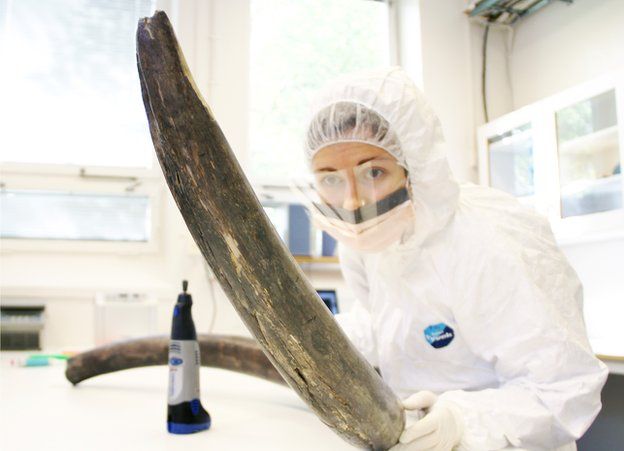What Animal Has A Similar Dna Sequence To A Woolly Mammoth
Mammoth genome sequence completed
By Pallab Ghosh
Science correspondent, BBC News
 Prototype source, Love Dalén
Prototype source, Love Dalén
Past drilling into mammoth tusks and other remains, researchers at present have the extinct creatures' complete genetic code
An international team of scientists has sequenced the complete genome of the woolly mammoth.
A US squad is already attempting to report the animals' characteristics by inserting mammoth genes into elephant stalk cells.
They desire to find out what made the mammoths dissimilar from their modern relatives and how their adaptations helped them survive the ice ages.
The new genome study has been published in the journal Electric current Biological science.
Dr Beloved Dalén, at the Swedish Museum of Natural History in Stockholm, told BBC News that the first ever publication of the total Dna sequence of the mammoth could help those trying to bring the fauna back to life.
"Information technology would exist a lot of fun (in principle) to come across a living mammoth, to see how it behaves and how information technology moves," he said.
But he would rather his research was non used to this finish.
"Information technology seems to me that trying this out might lead to suffering for female elephants and that would not be ethically justifiable."
Dr Dalén and the international group of researchers he is collaborating with are non attempting to resurrect the mammoth. Merely the Long At present Foundation, an organisation based in San Francisco, claims that it is.
Now, with the publication of the consummate mammoth genome, it could be a step closer to achieving its aim.
On its website, the foundation says its ultimate goal is "to produce new mammoths that are capable of repopulating the vast tracts of tundra and boreal woods in Eurasia and North America.
"The goal is not to make perfect copies of extinct woolly mammoths, but to focus on the mammoth adaptations needed for Asian elephants to alive in the common cold climate of the tundra.
Paradigm source, flickr/london looks
Could the mammoth become a familiar sight beyond parts of the the world once again?
The foundation is supporting a team based at Harvard Academy, which is using genetic engineering techniques to insert mammoth genes into living elephant cells.
So far, the foundation says it has placed mammoth genes involved in blood, fat and pilus into elephant stem cells in order to study the furnishings of these genes.
The researchers hope to produce mammoth ruddy blood cells to see how much oxygen they might accept carried and so learn more than about the physiology of the animals. Similar tests, they claim, tin can be done to investigate how their fat and hair grew.
The Long Now Foundation's stated aim is to insert synthetically created mammoth genetic material inside an elephant egg, which it would then identify in a zoo elephant. It believes that cloning attempts can begin by 2018.
Many experts, however, believe that there are considerable obstacles in the way of creating a mammoth in this way. Among them is Prof Beth Shapiro, of the Academy of California, Santa Cruz, who has written a volume called How to Clone a Mammoth.
"There is an enormous difference betwixt having a cell living in a dish in a lab whose genome contains a few changes and having a living creature that is a little chip mammoth-similar," she told BBC News.
De-extinction
"We'd accept to utilise that cell to create an embryo, get an embryo into a maternal host, and establish a pregnancy and hope that pregnancy was successful."
Prof Shapiro is opposed to what is known in the field equally "mammoth de-extinction".
"Elephants do non fare well in captivity, struggle with assisted reproduction, and should be allowed to make more elephants.
"Secondly, elephants are highly social creatures and there is no reason to suspect that mammoths were not. I mammoth would be necessarily alone in the world. Information technology could not be released into the freedom of the Chill until at that place were many of them. Until we can make many mammoths without using elephants, to my mind information technology is ethically unsound."
Dr Dalén and his colleagues sequenced the mammoth genome in guild to learn more nigh what happened when the creature went extinct effectually 4,000 years ago on Russian federation's Wrangel Isle.
They compared the Dna of one of the last creatures to accept lived with i that lived 45,000 years agone when mammoths were more commonplace.
The written report showed that the population on Wrangel Island was so small-scale that the animals became inbred for the last v,000 years of their being. Dr Dalén cannot say categorically that inbreeding was the crusade or contributed to their eventual demise because it doesn't e'er take a negative effect, simply he thinks that his report makes this a singled-out possibility.
"When we look at modern animals we know that most animals that are inbred suffer from information technology. And so nosotros retrieve information technology is likely that information technology had some sort of negative effect," he said.
The genetic information also showed that there was a dip in the mammoth population 300,000 years ago.
"Nosotros were very surprised past this," Dr Dalén said. "It seems like there was an ancient bottleneck. It was before mod humans were in this region and nosotros are non entirely sure what caused it. A good bet is that it was due to a by modify in climate."
Prof Shapiro believes that there is much more than to come from the new mammoth DNA.
"We'll probably notice answers to questions that we've yet to call back of. Genomes are rich sources of data, and we take only tapped the surface of that data," he said.
Related Cyberspace Links
The BBC is not responsible for the content of external sites.
Source: https://www.bbc.com/news/science-environment-32432693
Posted by: millerpithenclacke.blogspot.com

0 Response to "What Animal Has A Similar Dna Sequence To A Woolly Mammoth"
Post a Comment